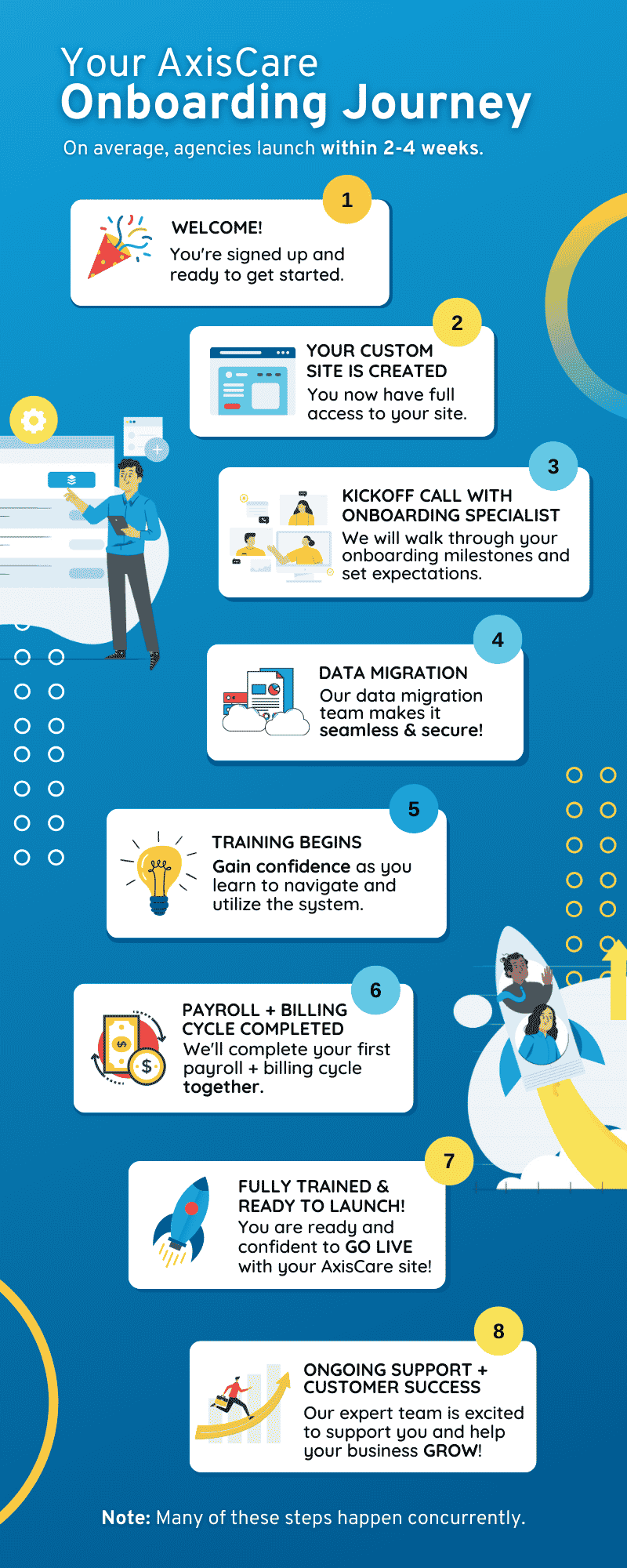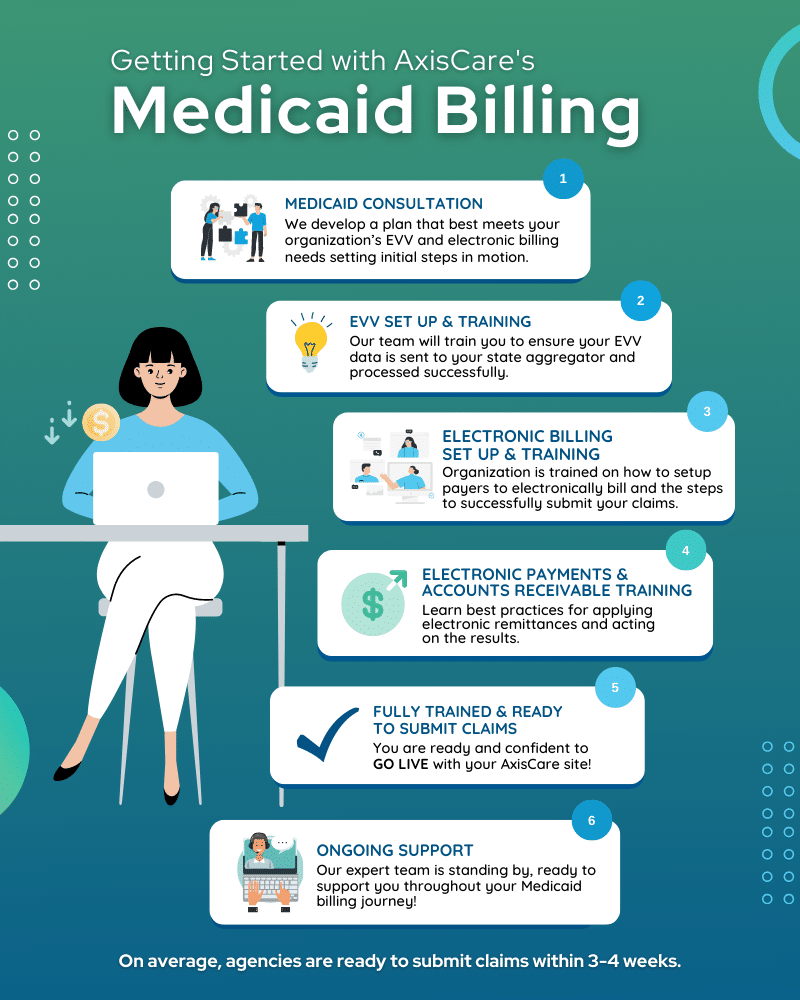You’ve decided to make the digital leap to home care software, but the implementation process looms. You’re in uncharted waters and aren’t sure how complex the process is going to be – how tedious, how lengthy, how opaque.
While you can’t predict the future, you can certainly come prepared. And the easiest way to approach any major challenge is to break it down into digestible steps. This piece will walk you through every aspect of choosing, rolling out, and maintaining a home care software solution for the long haul, so you can tackle your implementation with confidence.
Key Features to Consider When Choosing a Home Care Software
Implementation is a complex beast, so you’ll only want to go through it once, if at all possible! That means choosing a home care agency software that’s right for you, right off the bat. Be on the lookout for these high-value features and benefits as you vet different platforms:
User-Friendly Scheduling
Agencies lose countless hours every week manually assigning caregivers to tasks, scrambling to fill open shifts, and accommodating last-minute changes. Your chosen software should make this process completely intuitive, using digital tools that intelligently pair staff with clients and provide a user-friendly interface.
Customizable Forms
Reduce manual and repeat data entry with forms and document templates tailored to your agency. Customize permissions, define and auto-populate fields, and even allow clients and caregivers to provide signatures from their smartphone or tablet.
Detailed Reporting
Collecting and analyzing data is the only way to know if your agency is heading in the right direction. You’ll be inputting a huge quantity of operational information into your new software, so it should be able to crunch insights that help you run a more efficient business and identify areas of improvement.
Billing and Payroll Integrations
The entire point of implementing home care software is to do it all under one roof. Make sure your vendor has an integration marketplace that syncs with your chosen billing and payroll apps so you can seamlessly manage the financial side of your business.
Electronic Visit Verification (EVV) Compatibility
EVV implementation and home care implementation go hand in hand. Remain compliant with the industry standard for visit tracking by capturing all essential care details and required visit information on the spot using a caregiver mobile app.
Steps for Implementing Home Care Software
As long as you take the implementation process one step at a time, you’ll be up and running with your new solution before you know it. Here’s our tried and true playbook for the entire onboarding lifecycle.
Preparation and Planning
Start by outlining your goals for home care implementation. Which workflows are causing your agency the most friction? Which ones are wasting the most time and resources? What are your most significant opportunities for improvement, whether it’s efficiency, care quality, operational, or all the above? Begin your software search with these north stars in mind, and make sure to ask plenty of questions during the demo stage with each provider.
Implementation Strategies
Structure makes for a smooth transition. You’ll need a dedicated group of people and resources—including a project lead — to see the implementation through, manage timelines, and address challenges as they arise.
Maintaining open lines of communication is also a must for managing employee expectations and addressing their concerns. Your team should understand why these changes are happening, how the new platform will benefit them, and how their workflows are expected to change. If they feel blindsided or underprepared, it will be significantly more difficult to get their buy-in.
Post-Implementation Practices
Getting the last employee onboarded is far from the end of your implementation process. Monitoring your new system’s performance and conducting regular reviews will identify any issues that weren’t caught during the initial rollout. Actively soliciting feedback from caregivers and in-office staff will round out the iteration process nicely, ensuring you can maximize your new software’s utility and effectiveness over time.
The Implementation Process
Now that we’ve covered the broad strokes of implementation, let’s break them down into actionable steps.
- Assemble your implementation team: designate a project lead and/or core team to champion the transition process. They’ll oversee each step, ensure the implementation is unfolding smoothly, and act as a go-to resource for any employees who have questions about the incoming changes.
- Check compatibility: ensure your chosen software is compatible with your current tech stack, such as your scheduling, billing, and EHR platforms. They should all be able to integrate, creating a single, convenient hub for all your operational touchpoints.
- Prepare your data: to avoid errors, duplication, and missing information, clean and organize your data, then back it up before the migration begins for an added layer of security.
- Migrate!: transfer all of your client, caregiver, and operational data over to your new system. You may choose to use internal resources for this task or enlist the help of a home care data migration specialist.
- Set up your software: once your data has moved into its new home, customize your settings, permissions, and workflows to align with your operational goals.
- At-scale implementation: launch your new system company-wide, train your staff in the process, and continue to make any necessary adjustments as feedback rolls in.
AxisCare is committed to sticking with agencies throughout onboarding to ensure successful implementation. Unlike other companies, we don’t just set you up and leave. We work closely with you to fully configure your system, ensuring it’s customized to meet your needs. A good company will walk you through the onboarding process, and that’s exactly what our team is dedicated to doing. In fact, AxisCare goes even further by staying with you through a full billing and payroll cycle, ensuring you’re confident and fully prepared to handle everything independently.
The Importance of Training and Deployment
Proper post-implementation practices are key to overcoming challenges in online home care software adoption. First, preparing staff to become future power users requires a training program that can accommodate all levels—not just the most tech-savvy. Workshops supported by on-demand video tutorials and step-by-step guides can get employees up to speed, while role-specific training will show each team how to make the most of the software for their routine tasks.
In the weeks, months, and even years that follow, agencies should provide ongoing technical assistance and establish a dedicated support team – whether in-house or using a third party – to troubleshoot issues. Issues can arise at any time, not just during the initial rollout, and new staff members are sure to have their own questions.
Bridging the Gap With AxisCare
Implementations at this scale are a big responsibility, but the benefits are well worth the effort. The initial time and resource investment will pay dividends in the form of countless hours saved down the road and vastly improved patient satisfaction. How can software improve home health care for your agency specifically? You can ask our experts anything and receive personalized advice during a free demo.









